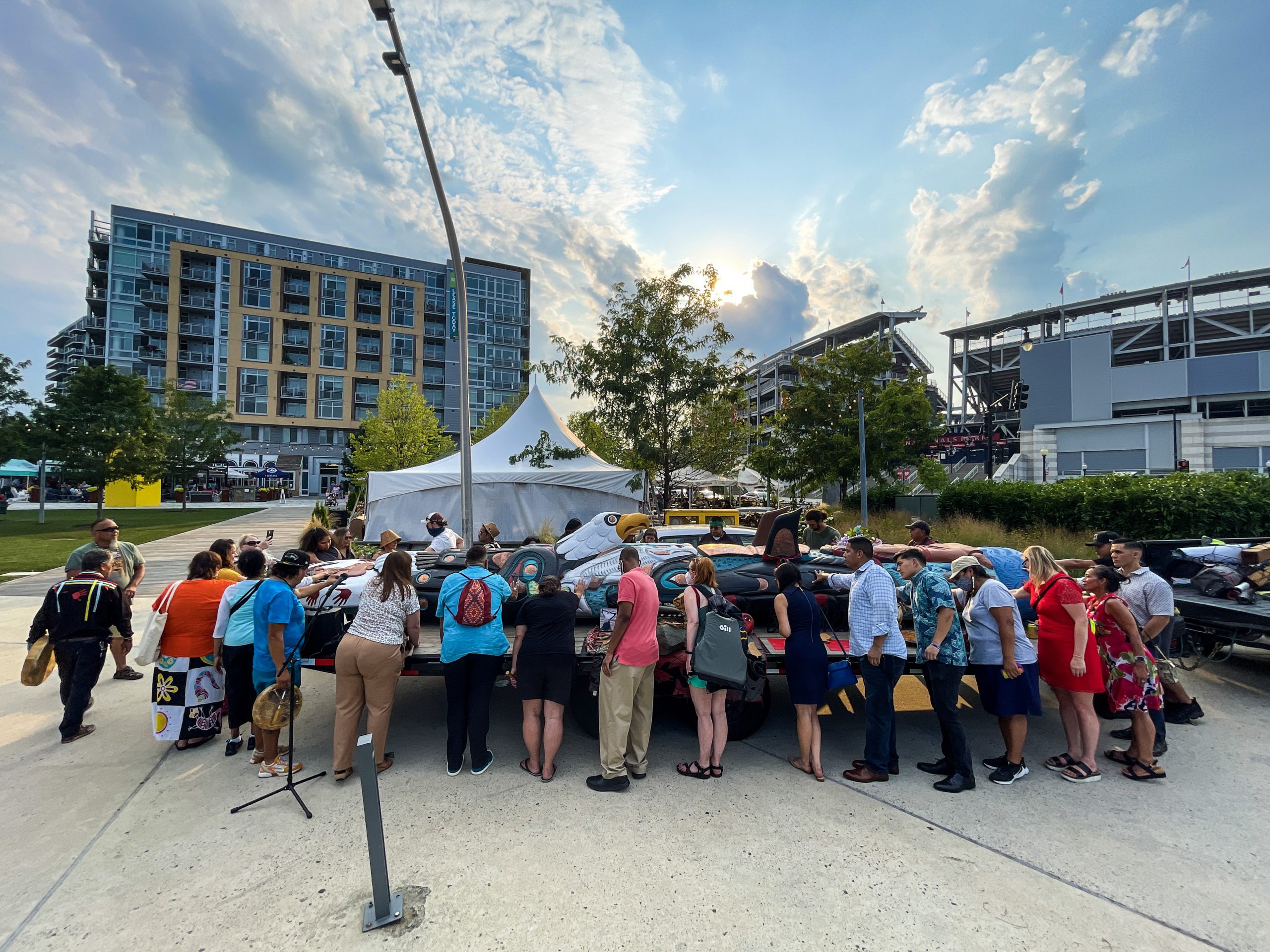Indianz.Com > News > Red Road to DC brings awareness to sacred sites and tribal rights

Red Road to DC brings awareness to sacred sites and tribal rights
Thursday, July 29, 2021
Indianz.Com
WASHINGTON, D.C. — After 20,000 miles and 115 stops across the country, a group of Native carvers and elders have finally arrived in the nation’s capital, bringing much-needed attention to sacred sites and tribal rights along the way.
The House of Tears Carvers began their journey on the Lummi Nation in Washington state two weeks ago. The 25-foot, 5,000-pound totem pole they created has traveled to some major battlegrounds in the fight to protect tribal ways of life, including the Standing Rock Sioux Reservation in North Dakota, where opposition to the Dakota Access Pipeline has survived three U.S. presidential administrations.
“This is not a Lummi fight or Standing Rock fight,” Fredrick “Phreddie” Lane, whose traditional name is Sul Ka Dub, said of the journey across the United States. “This is our fight!”


With the U.S. Capitol as the backdrop, the Native delegation will continue to press the need for free, prior and informed consent of tribal nations when it comes to U.S. law and policy. “As monuments to colonialism are dismantled across the nation, the totem pole creates a new kind of monument, one that serves to build alliances around our collective obligation to care for our lands and waters for the generations to come,” said Rosalyn LaPier, a citizen of the Blackfeet Nation and board member at The Natural History Museum, a collective that helped organize the nationwide tour. “It also challenges us to address environmental racism and the growing climate crisis,” LaPier said. The totem pole presentation to Secretary Haaland is scheduled to begin around 2pm Eastern. A livestream is expected to be available through redroadtodc.org and facebook.com/totempolejourney. Following the event on the National Mall, the totem pole will remain on display outside of the National Museum of the American Indian through Saturday. The Kwel’ Hoy: We Draw the Line exhibit runs through September 9. The Red Road to DC departed the Lummi Nation on July 14. One of the first major stops took place the following day along the Snake River in Idaho, where the Nez Perce Tribe is calling for the removal of four dams in order to restore runs of salmon and protect treaty rights. “Time is running out to protect our sacred salmon,” said Vice Chairman Shannon Wheeler. “This is a crisis that threatens our way of life, and it is a violation of our treaty rights. The federal government is failing to uphold the promises made to our ancestors when we ceded our lands.” On July 17, the delegation visited the Bears Ears National Monument in Utah, which has been the subject of high-profile political and legal disputes. Back in 2017, Republican former president Donald Trump dramatically reduced the boundaries of the site during his first year in office, over the objections of tribes whose ancestral homes, sacred sites and burial grounds are located there. “Bears Ears is a place of healing,” said Woody Lee, the executive director of Utah Diné Bikéyah, which has supported protections for the site. “The canyons hold our songs, memories, and history. This place should be permanently protected and under the stewardship of the tribes who know the land better than anyone.”After thousands of miles traveled and dozens of events across the country on the #RedRoad2DC to protect sacred sites and AI/AN rights, the Totem Pole Journey ends today.
— National Congress of American Indians (@NCAI1944) July 29, 2021
RSVP to today’s events in Washington, D.C. and learn more: https://t.co/17pSFQWVuG pic.twitter.com/j8ApdYghoW

Red Road to DC
Search
Filed Under
Tags
More Headlines
Cronkite News: President Trump targets Smithsonian in another anti-DEI effort
Native America Calling: Counteracting a pollinator crisis
Cronkite News: Arizona State University hosts annual powwow
Chickasaw Nation citizen T.W. Shannon joins Department of Agriculture
NAFOA: 5 Things You Need to Know this Week (April 14, 2025)
Bryan Warner: Cherokee Nation invests in food sovereignty
Native America Calling: Tribal libraries, museums, low-income heating and food sovereignty on the chopping block
Native America Calling: Contemporary Pueblo architects reclaim ancestral knowledge
Native America Calling: Flexing tribal strength during turbulent times
National Indian Health Board names permanent chief executive amid major change
Native America Calling: Medicaid, Medicare, health care, and food safety on the line
Montana Free Press: Blackfeet Nation citizens cite treaty rights in lawsuit over tariffs
Cronkite News: A ‘mural with a message’ rises in Arizona
Chuck Hoskin: Cherokee Nation is an economic powerhouse
Native America Calling: Philanthropy fills in the gaps
More Headlines
Native America Calling: Counteracting a pollinator crisis
Cronkite News: Arizona State University hosts annual powwow
Chickasaw Nation citizen T.W. Shannon joins Department of Agriculture
NAFOA: 5 Things You Need to Know this Week (April 14, 2025)
Bryan Warner: Cherokee Nation invests in food sovereignty
Native America Calling: Tribal libraries, museums, low-income heating and food sovereignty on the chopping block
Native America Calling: Contemporary Pueblo architects reclaim ancestral knowledge
Native America Calling: Flexing tribal strength during turbulent times
National Indian Health Board names permanent chief executive amid major change
Native America Calling: Medicaid, Medicare, health care, and food safety on the line
Montana Free Press: Blackfeet Nation citizens cite treaty rights in lawsuit over tariffs
Cronkite News: A ‘mural with a message’ rises in Arizona
Chuck Hoskin: Cherokee Nation is an economic powerhouse
Native America Calling: Philanthropy fills in the gaps
More Headlines